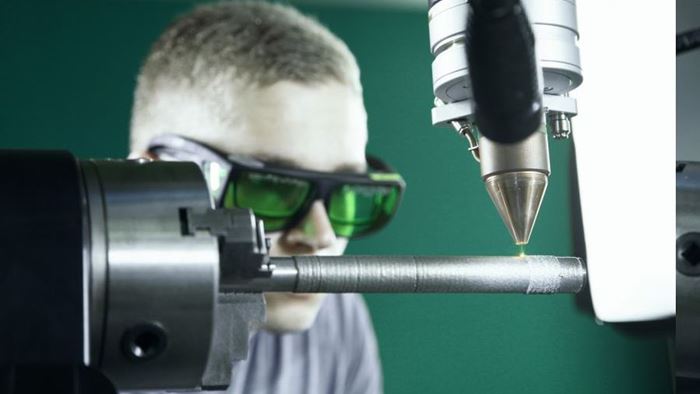Direct Metal Deposition Extends Life of Sensors
A specialized welding system equipped with a powder nozzle for direct metal deposition helps to extend the life of oil and gas sensors.
Share
The industrial sensors are used to precisely and reliably monitor temperatures, flow rates and pressure over long periods of time in oil and gas pipelines are subjected to extreme stresses in the process. Onshore gas pipelines have a high internal pressure of 100 bars, and offshore pipelines can reach even 200 bars or more. Sensor elements used to monitor the flow suffer considerable wear as a result of corrosion and abrasion, which shortens their lifetimes and necessitates costly repairs.
To protect against wear, sensors are commonly coated with Stellite. The cobalt-chromium-based alloys known by this name are difficult to machine, so the conventional approach is to apply composite-clad layers with a total thickness of several millimeters. However, the intense heat applied during the process results in considerable mingling of the sensor’s material with the Stellite cladding, shortening its lifetime.
A new technique that combines a powder-fed direct metal deposition (DMD) nozzle with a laser welding system avoids these problems. The team of the R&D department of OR Laser spent a year collaborating with the Fraunhofer Institute to develop an efficient, easy-to-install powder nozzle that works with high repeatability and is suitable for automated processes. The nozzle is manufactured in Germany and enables a combination of wire- and powder-based laser cladding using OR Laser’s compact Evo Mobile laser welding system. The system uses relatively low laser output levels starting at 200 watts, but offers deposition rates ranging to 5,000 mm³/hr. and is said to be highly efficient.
When equipped with the powder nozzle for direct metal deposition, the EVO system’s laser minimally melts the surface of the sensor, and only at scattered points. Metallic powder with grain sizes between 45 and 90 microns is fed coaxially to the laser beam and permanently fuses with the object’s surface. According to OR Laser, the coaxial arrangement permits deposition of material independently of the direction of cladding, so that the workpiece can be freely rotated in all directions and, if required, even “grow” in three dimensions. To prevent oxidation and the formation of tiny bubbles, the work is done in a shielding atmosphere of argon.
The laser parameters can be dynamically adjusted to changing conditions on the fly. The company’s CAD/CAM solution, Orlas Suite, is able to program the cladding strategy for complex geometries and align the require laser tracks with micron accuracy. Track widths between 200 microns and 2 mm are possible.
According to OR Laser, this approach enables precise deposition of the material and low heat penetration for an undistorted, crack-free coating. The resulting surface quality is free of pores and cracks, very close to the required final contours, and neat, OR Laser says. The sensor itself is said to be hardly affected by this minimally invasive technique, while its resistance to wear is greatly improved.
Related Content
-
Elementum 3D’s High-Strength Aluminum Alloy Eliminates Need for Heat Treatment
Elementum 3D’s A5083-RAM5 aluminum alloy enables manufacturers to print advanced components from a high-strength aluminum alloy with reduced postprocessing time and cost.
-
ConocoPhillips Sees Oil and Gas Supply Chain Opportunity With Additive Manufacturing
Production of parts when needed and where needed can respond to the oil and gas sector’s multibillion-dollar challenge of holding parts in inventory. The supply chain benefit will justify additive even before the design freedoms are explored.
-
The Rise of AM Factories, Metal 3D Printing, Machining Synergy and Favorite Stories from 2023: AM Radio #47
Additive Manufacturing Media editors reflect on the top 10 stories by pageviews and then share their favorites, regardless of ranking, in this podcast episode.

.jpg;width=70;height=70;mode=crop)














.png;maxWidth=300;quality=90)


